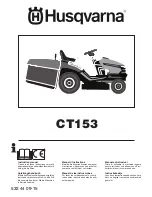
7 - 35
7 Electrical System Service
Component Tests
C. Battery Tests
GENERAL
If the battery is producing 12 volts and the battery cables
have continuity, the rest of the cranking system can be
systematically tested. However, a full test of the battery
includes cleaning, testing battery charge (hydrometer
test), and testing its ability to deliver current (heavy load
test).
NOTE: Before testing, check the battery for any damage
such as a loose post or cracks. Damaged batteries must
be replaced.
C-1 HYDROMETER TEST
1. Remove the vent caps (A, Figure 34).
2. Check each cell using a hydrometer.
3. All cells should have a specific gravity of 1.27 or high-
er. If the cells vary by more than .050 points, charge
the battery and recheck.
If one or more cells read below 1.265, charge at
5 Amps, checking hourly. If the low cell or cells do not
improve within three hours of charging, replace the
battery.
4. Replace the cap when finished.
C-2 CHECK ELECTROLYTE LEVEL
1. Remove the battery vent cap (A, Figure 62) and
make sure the breather holes are open.
2. Check that fluid is even with the bottom of the split
rings (B, Figure 62). If not, fill with distilled water.
Replace vent cap when done.
C-3 TEST BATTERY VOLTAGE
1. Test the battery voltage: set VOM to VDC.
2. Place one test probe of the VOM on the batteries
positive post and one probe on the negative post
(see Figure 35). Note and record the battery voltage
as it will be referenced in later tests. It should be
approximately 12 VDC.
C-4 HEAVY LOAD TEST
1. Follow the load tester manufacturer’s instructions;
connect the battery tester to the battery.
2. Discharge the battery under a fixed load at three
times the ampere-hour rating for approximately
15 seconds, then read the terminal voltage.
C-5 CLEAN BATTERY
1. Disconnect the battery cables.
2. Remove the battery from the battery compartment.
3. Remove dirt and corrosion with a solution of one part
baking soda and seven parts water.
Figure 35. Check Battery Voltage
Figure 34. Check Battery Electrolyte
A. Battery Cap
B. Split Ring
A
B
WARNING
Be careful when handling the battery. Avoid
spilling electrolyte. Keep flames and sparks away
from the battery.
When removing or installing battery cables,
disconnect the negative cable FIRST and reconnect
it LAST. If not done in this order, the positive
terminal can be shorted to the frame by a tool.
4. Clean the posts with a wire brush until the metal is
shiny.
5. Reinstall battery and coat the terminals with petroleum
jelly to prevent corrosion.
Not
for
Reproduction
Содержание AGCO Allis 2000 Series
Страница 1: ...USE N o t f o r R e p r o d u c t i o n...
Страница 18: ...1 16 1 General Information Notes N o t f o r R e p r o d u c t i o n...
Страница 24: ...2 Troubleshooting Notes 2 6 N o t f o r R e p r o d u c t i o n...
Страница 52: ...5 Belt Replacement Notes 5 6 N o t f o r R e p r o d u c t i o n...
Страница 101: ...7 33 7 Electrical System Service Troubleshooting Notes N o t f o r R e p r o d u c t i o n...
Страница 114: ...7 46 7 Electrical System Service Notes N o t f o r R e p r o d u c t i o n...
Страница 126: ...8 Power Steering Service Notes 8 12 N o t f o r R e p r o d u c t i o n...
Страница 162: ...11 Transaxle Removal Installation Notes 11 10 N o t f o r R e p r o d u c t i o n...
Страница 206: ...13 Engine Removal Installation Notes 13 36 N o t f o r R e p r o d u c t i o n...
Страница 244: ...17 Miscellaneous Component Service Notes 17 4 N o t f o r R e p r o d u c t i o n...
Страница 304: ...19 Implement Lift Service Notes 19 10 N o t f o r R e p r o d u c t i o n...
Страница 312: ...20 Power Steering Unit Service Notes 20 8 N o t f o r R e p r o d u c t i o n...
















































